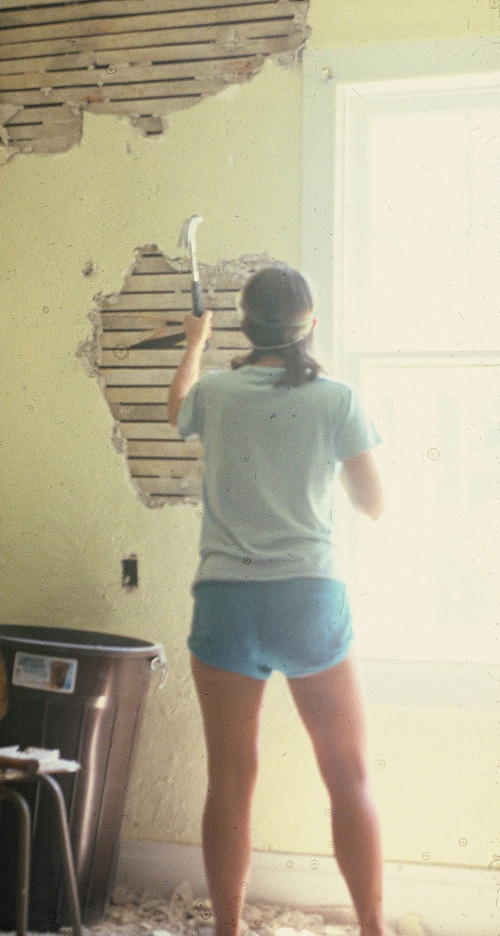This is the DIY history of the house that won’t get finished. Chapter links at bottom of the page.

Demolition is a necessary evil in most remodeling jobs. Sometimes it’s quite fun. But it’s mostly drudgery. You’re thinking sledge hammering, walls falling, window glass breaking, throwing toilets into holes with rocks at the bottom (done that), clouds of dust. But what you get is picking up piece after ripped off piece and trudging to the Dumpster®, only to have to do it again and again.
Tools
In the tool area, I recommend, a big hammer – I have both a long-handled and a short one-handed sledge – and a pry bar. I find a short so-called flat bar to be more useful than the bigger, give-you-more-leverage hook-ended crowbar. Though it’s good to have both.
Then there’s the cream of the crop of demolition tools, the reciprocating saw. Often called, no matter who actually manufactured it, a Sawzall®, which is a trademark of the Milwaukee Electric Tool Company. A reciprocating saw pushes and pulls a blade that sticks out the front.
This blade can be brought straight up against a surface or jammed into cracks, or pushed through drywall. Blades , come in all manner of types including those that cut through nails, perfect for demolition work.
Good demolition is a creative endeavor, the goal of which is to get the desired removal done with the least effort and the least amount of cleanup, which leads me to the subject of Dumpsters®, more generically called roll off containers.
Dumpsters® (like Sawzall, it’s an often-misused trademarked term.), went for two or three hundred dollars for a couple of weeks rental (I don’t know what it is now.) We were also charged a “pulling fee” to get the thing to the dump, which is, of course, the whole point of renting the Dumpster®.
We didn’t go the Dumpster® route until the Final Phase when we had the budget to get a 30 yarder with a name, “Bitch Faggot” painted below some Arabic resembling gang graffiti. Subsequently we have rented two other Dumpsters®, which were, sadly, nameless.
The worst demo on this house was for the first front door move. The living room had plaster walls, old, lumpy, and, we suspected, uninsulated. They had to go.
A very bad experience
So, we began hammering at the plaster and prying the wooden lathe off the walls, shoveling the detritus into a couple of big trash cans to be hauled to the dump in our Toyota mini truck. That became tedious so we began piling the chunks of plaster and sinus-closing dust into the center of the room.
From the day we moved into This House we had suffered from an epidemic of Chinese elm beetles, bugs, which we abbreviated CE. CEs are the size of a pencil eraser and smell of rotting leaves. As the plaster came off the wall, we uncovered colonies and sheer mats of these bugs. With about three quarters of the plaster and lath and multitudes of elm beetles part of the now impressive pile in the center of the room we closed up the house and left town.
A week in Boston to attend my brother’s wedding, then I flew directly back. Judy came back by way of Indiana for several days with her family. I opened the newly relocated front door and could barely breathe in the funk of ages old plaster dust and dead Chinese Elm Beetles And all over the floor masses of dead and living Chinese Elm Beetles, thousands of them, hell, who am I kidding, tens of thousands of them.
Even a single CE disgusted Judy. I was pretty sure she would have issues with thousands. As I stood there breathing the funk, I consoled myself with the thought that since we weren’t actually married at the time, there would be no need for divorce proceedings. But I did wonder which one of us would have to take custody of This House, knowing of course that that loser would probably be me.
The vacuum cleaner seemed like the best idea. In those days I did not own an industrial strength shop vac, and the dust and bits of plaster threatened to end the life of our everyday Eureka. In the end I shoveled out what I could fit in our three trash cans, swept the ancient carpet with a broom, and then vacuumed the remaining bugs and dust and smaller pieces of plaster. And I did it all in tune with my new mantra, tearing down; fun, cleaning up; not. But, once you get everything out of the way, you can start building in earnest.
I think it’s important to point out for the record that we got married a year later. And, as I write this 30 years later, we’re still married. To each other. Proving, I think, that radical DIY doesn’t have to cost a marriage. But it can be tough.